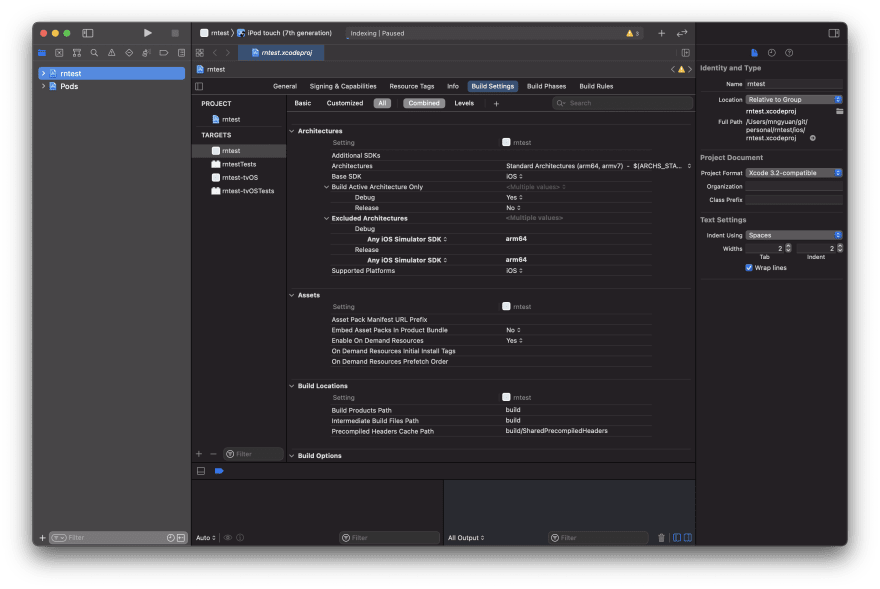

- IOS POD DELETE DERIVED AND BUILD FOLDER HOW TO
- IOS POD DELETE DERIVED AND BUILD FOLDER UPDATE
- IOS POD DELETE DERIVED AND BUILD FOLDER PLUS
- IOS POD DELETE DERIVED AND BUILD FOLDER FREE
IOS POD DELETE DERIVED AND BUILD FOLDER UPDATE
Now, open the NetStatus.swift file and update the class definition as follows: As an additional tip, changes made to embedded projects are not instantly visible to other modules, so build each time you want to make any changes visible to the demo project. As a side note, the recommended way to implement a custom framework is by embedding it into a demo project and discovering such kind of problems as you go. You will find the NetStatus.swift file there. NetStatusDemo is not capable of “seeing” it right now so let’s fix that.Įxpand the NetStatus.xcodeproj container and then expand the NetStatus and Source groups subsequently. It all has to do with the access control and default access levels that modules have in Swift! NetStatus class has the internal access level set by default, which makes it visible only inside its own module, the NetStatus framework. You’ll see that an error is appearing multiple times! Why’s that happening? Once building is finished, open the ViewController.swift file and import the NetStatus framework.īuild again. The selected framework will also show up in the Linked Frameworks and Binaries.īuild the project once by pressing Cmd + B in your keyboard, or through the Product > Build menu in Xcode.
IOS POD DELETE DERIVED AND BUILD FOLDER PLUS
Click the plus (+) button in the Embedded Binaries and select the amework from the dialog that appears. Open the NetStatusDemo target and go to General tab. Do not move to trash, otherwise you’ll delete the NetStatus framework files. Keep in mind that if you want to delete the project you just dragged from the NetStatusDemo project you should remove the references only. Note: Once again, make sure that you’ve closed NetStatus project before you drag it into the NetStatusDemo. Now, go to Finder and find the NetStatus Xcode project ( NetStatus.xcodeproj container). Then, in the NetStatusDemo project select and delete the NetStatus.swift file from the Project Navigator. But is it actually working? We will verify that, so at first close the NetStatus project we just created. Is the Framework Working?Īll steps above are what we needed for creating our own small framework based on the NetStatus class. After dragging, make sure to select the Copy items if needed checkbox and that the NetStatus target is selected too. Once the NetStatus.swift file shows up on Finder, bring the NetStatus Xcode project in front again and drag-and-drop NetStatus.swift in the Source group in Xcode.


From the context menu select the option Show in Finder. Now switch back to the NetStatusDemo project, and right click on the NetStatus.swift file. Therefore, right click on the NetStatus root group and create a new one called Source. Generally, it’s considered to be a good idea to create a group for adding the source files and separate them from the rest project contents. Speaking of that, change the Deployment Target to 12.0, so we can use this framework on devices running iOS 12.0 and above. Most of the times you won’t have to do any modifications, except maybe for changing the version number or the deployment target: Once the project is created you will notice that not many files are contained in it. I would recommend to create a subfolder called NetStatus in the same root folder where NetStatusDemo project exists and save it there. I’ll be using NetStatus, and from now on NetStatus means the custom framework we’re creating, not the class unless it’s explicitly mentioned.įinally, find a folder to save the new project.

IOS POD DELETE DERIVED AND BUILD FOLDER FREE
Note: You are free to set any product name for the framework we are about to create. Next, set the proper Team, Organization Name, and Organization Identifier values, and as a product name use the name of our class: NetStatus. In the first step, choose the Cocoa Touch Framework as your template option: To begin, open File > New > Project… in Xcode to start creating a new project. Okay, let’s get started to create a distributable library.
IOS POD DELETE DERIVED AND BUILD FOLDER HOW TO
In case that you only want to learn how to create a pod, please download this project first. Note: If you haven’t checked the previous tutorial, I highly recommend you to take a look first. Moreover, the “recipe” that comes in the following parts can be followed many times for any custom framework you want to create in the future. Reusing NetStatus that way in multiple projects is going to be just like a walk in the park. In this tutorial, we will make this framework easily distributable and integratable by creating a pod using CocoaPods and we will even push it to GitHub. The framework seems to be working fine through the NetStatus class, so let’s go one step further and let’s create our own small, open-source framework that will be based on the NetStatus class. Welcome back! In the previous tutorial, you learned how to use the Network Framework to detect and monitor the network status.


 0 kommentar(er)
0 kommentar(er)
